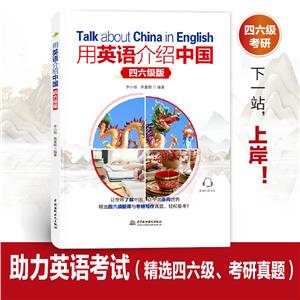前言
第1章 传统节日Traditional Chinese Festivals
1.1 Spring Festival(春节) 002
1.1.1 Etiquette Activities of Spring Festival(春节期间仪式活动) 003
1.1.2 The Foods in Spring Festival(节日饮食) 003
1.1.3 Customs in Spring Festival(春节习俗) 004
1.1.4 The Legend about the Origin of Chinese New Year(农历新年由来传说) 004
1.2 Lantern Festival(元宵节) 006
1.2.1 Etiquette Activities during Lantern Festival(元宵节礼俗活动) 006
1.2.2 The Special Food ? Yuanxiao in Lantern Festival(元宵节的特色饮食—元宵) 007
1.3 Qingming Festival(清明节) 008
1.3.1 The Foods and Customs in Qingming Festival(节日饮食及习俗) 008
1.3.2 The Origin of Tomb-Sweeping in Qingming Festival(清明节扫墓由来) 009
1.4 Dragon Boat Festival(端午节) 010
1.4.1 Customs about Dragon Boat Festival(端午节习俗) 010
1.4.2 The Origin of Dragon Boat Festival(端午节由来) 011
1.5 Mid-Autumn Festival(中秋节) 012
1.5.1 The Foods in Mid-Autumn Festival(节日饮食) 012
1.5.2 The Legend about Mid-Autumn Festival(中秋节传说) 013
1.6 Double Ninth Festival(重阳节) 015
1.6.1 Customs in Double Ninth Festival(重阳节习俗) 016
1.6.2 The Origin of Double Ninth Festival(重阳节由来) 018
第2章 饮食文化Chinese Culinary Culture
2.1 Color, Aroma and Taste(色香味俱全) 023
2.1.1 Cooking Methods(烹饪方法) 023
2.1.2 Seasonings(调料) 024
2.1.3 Yin-Yang Principle(阴阳原理) 024
2.1.4 Medicinal Function(医疗保健功能) 025
2.2 Eight Regional Cuisines(八大菜系) 025
2.2.1 Shandong Cuisine(鲁菜) 026
2.2.2 Sichuan Cuisine(川菜) 027
2.2.3 Guangdong Cuisine(粤菜) 027
2.2.4 Fujian Cuisine(闽菜) 028
2.2.5 Jiangsu Cuisine(苏菜) 028
2.2.6 Zhejiang Cuisine(浙菜) 029
2.2.7 Anhui Cuisine(徽菜) 030
2.2.8 Hunan Cuisine(湘菜) 030
2.3 Table Manners(餐桌礼仪) 031
2.3.1 Arrangement of Seats(座次安排) 031
2.3.2 Toasts(敬酒) 032
2.3.3 Serving Courses(上菜) 032
2.3.4 Chinese Chopsticks(中国筷子文化) 033
2.4 Chinese Tea Culture(中国茶文化) 034
2.4.1 Tea Classification(茶叶分类) 034
2.4.2 Tea Etiquette(上茶礼仪) 036
2.4.3 Three Cups of Tea of the Bai Ethnic Group(白族的三杯茶习俗) 037
2.5 Chinese Liquor Culture(中国酒文化) 038
2.5.1 Liquor Feasts(酒宴) 038
2.5.2 Drinkers’ Wager Game(划拳猜酒) 040
2.5.3 The Roles of Liquor in Art, Commerce and Health(酒在艺术、商业和健康方面的作用) 041
第3章 传统服饰Traditional Chinese Costume
3.1 The History of Development of Chinese Costume(中国服饰发展史) 049
3.1.1 Origin of Chinese Costume(中国服饰的起源) 049
3.1.2 Development of Chinese Costume(中国服饰的发展) 050
3.2 Distinct Features of Chinese Costume(中国服饰的鲜明特征) 054
3.2.1 Silk(丝绸) 054
3.2.2 The Silk Road(丝绸之路) 055
3.2.3 Embroidery(刺绣) 056
3.2.4 Batik(蜡染) 057
3.3 Typical Chinese Costumes(典型中国服饰) 058
3.3.1 Chinese Tunic Suit(中山装) 058
3.3.2 Cheongsam (qipao)(旗袍) 059
3.3.3 Hanfu(汉服) 060
3.3.4 Tang Costume(唐装) 061
第4章 建筑文化Chinese Architecture
4.1 Characteristics of Traditional Chinese Architecture(中国传统建筑特征) 066
4.1.1 Timber Framework(木质构架) 066
4.1.2 Plain, Flexible and Beautiful Layout(布局简洁灵活、美观大方) 067
4.1.3 The Building Materials(建筑用材) 067
4.1.4 Artistic Roof Design(屋顶艺术设计) 068
4.1.5 Colorful Paint(彩漆装饰) 068
4.2 Imperial Architecture(皇家建筑) 068
4.2.1 Imperial Mausoleums(皇陵) 069
4.2.2 Imperial Palaces(皇宫) 071
4.2.3 The Number Nine in Imperial Architecture(皇家建筑中的数字九) 075
4.3 Civilian Residential Housing(普通民居) 075
4.3.1 Beijing Quadrangles(北京四合院) 075
4.3.2 Shaanxi Cave Dwellings(陕西窑洞) 076
4.3.3 Huizhou Residential Houses(徽州古民居) 076
4.3.4 Hakka Earth Buildings(客家土楼) 077
4.3.5 Dai Bamboo House(傣族竹楼) 078
4.3.6 Mongolian Yurts(蒙古包) 078
4.5 Chinese Bridges(中国的桥梁) 079
4.5.1 The Stone Arch Bridge(石拱桥) 079
4.5.2 The Zigzag Bridge(曲桥) 080
4.5.3 The Pavilion Bridge(亭桥) 081
4.6 Typical Chinese Structures and Ornaments(典型的中国建筑装饰) 082
4.6.1 Chinese Stone Lions(中国石狮) 082
4.6.2 Huabiao(华表) 083
4.6.3 Pavilions(亭) 084
4.6.4 Pagodas(塔) 085
4.6.5 Paifang(牌坊) 086
第5章 文学作品Chinese Literature
5.1 Classical Chinese Literature(中国古典文学) 094
5.2 Modern Literature(现代文学) 108
5.3 Contemporary Literature(当代文学) 111
第6章 传统艺术Traditional Chinese Arts
6.1 Calligraphy and Painting(书法与绘画) 120
6.1.1 Calligraphy(书法) 121
6.1.2 Painting(绘画) 125
6.1.3 Four Treasures of the Study(文房四宝) 127
6.2 Traditional Chinese Operas(传统戏曲) 128
6.2.1 Beijing Opera(京剧) 129
6.2.2 Other Major Traditional Chinese Operas(其他主要的中国传统戏曲) 131
6.3 Folk Performing Arts(民俗表演艺术) 135
6.3.1 Acrobatics(杂技) 136
6.3.2 Quyi(曲艺) 136
6.3.3 Puppet Play(木偶戏) 138
6.3.4 Shadow Play(皮影戏) 139
6.4 Traditional Musical Instruments(传统乐器) 139
6.4.1 Plucked Instruments(弦乐器) 139
6.4.2 Percussion Instruments(打击乐器) 141
6.4.3 Wind Instruments(管乐器) 141
6.5 Traditional Chinese Ceramics(传统陶瓷) 142
6.5.1 The Neolithic Age(新石器时代) 142
6.5.2 The Xia, Shang, Zhou, and Spring and Autumn Periods(夏商周和春秋战国时期) 143
6.5.3 The Qin and Han Dynasties(秦汉时期) 143
6.5.4 The Wei, Jin, Southern and Northern Dynasties(魏晋南北朝时期) 144
6.5.5 The Sui and Tang Dynasties(隋唐时期) 145
6.5.6 The Song and Yuan Dynasties(宋元时期) 145
6.5.7 The Ming and Qing Dynasties(明清时期) 146
第7章 教育与科技Education, Science & Technology
7.1 Education(教育) 151
7.1.1 Development of Traditional Education(传统教育的发展) 152
7.1.2 Contemporary Education(当代教育) 155
7.1.3 Higher Education(高等教育) 158
7.1.4 Adult Education(成人教育) 159
7.1.5 Special Education(特殊教育) 159
7.1.6 Vocational Education(职业教育) 160
7.1.7 Education for Ethnic Minority Groups(少数民族教育) 160
7.1.8 International Exchanges and Cooperation(国际交流与合作) 161
7.2 Scinece and Technology(科技) 161
7.2.1 Ancient Science and Technology(古代科学技术) 162
7.2.2 Modern Scientific and Technological Achievements(现代科技成就) 167
第8章 二十四节气The Twenty-Four Solar Terms
8.1 The Six Solar Terms in Spring(春季的六个节气) 179
8.2 The Six Solar Terms in Summer(夏季的六个节气) 182
8.3 The Six Solar Terms in Autumn(秋季的六个节气) 185
8.4 The Six Solar Terms in Winter(冬季的六个节气) 190
第9章 中国名山Magnificent Mountains in China
9.1 Mount Taishan(泰山) 198
9.2 Mount Huangshan(黄山) 201
9.3 Mount Emei Scenic Area, Including Leshan Giant Buddha
(峨眉山—乐山大佛) 202
9.4 Mount Wuyi(武夷山) 204
第10章 世界自然遗产World Natural Heritage
10.1 Huanglong Scenic and Historic Interest Area(黄龙风景名胜区) 209
10.2 Wulingyuan Scenic and Historic Interest Area(武陵源风景名胜区) 210
10.3 Three Parallel Rivers of Yunnan Protected Areas(云南三江并流保护区) 211
10.4 Mount Sanqingshan National Park(三清山国家公园) 213



















